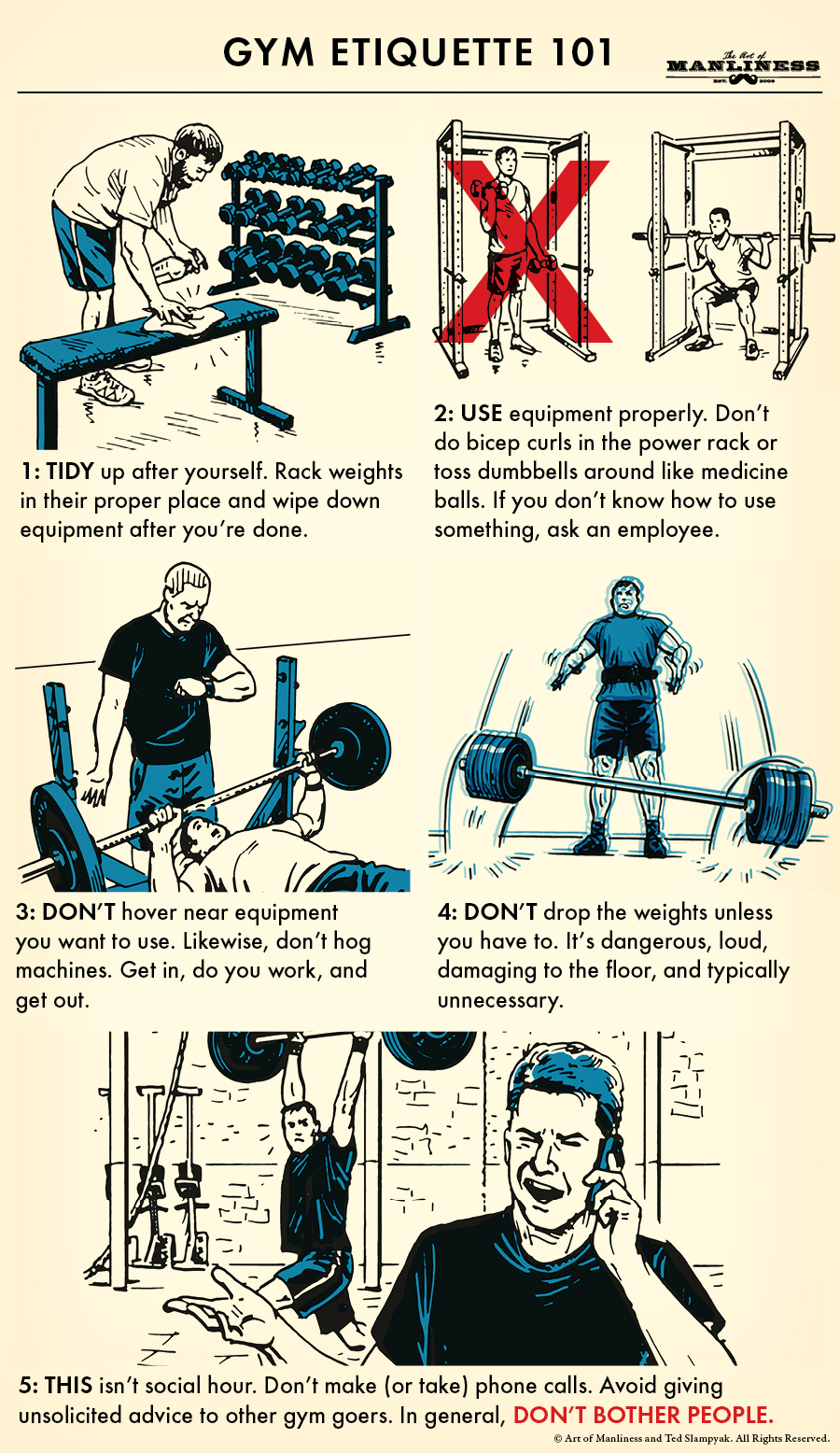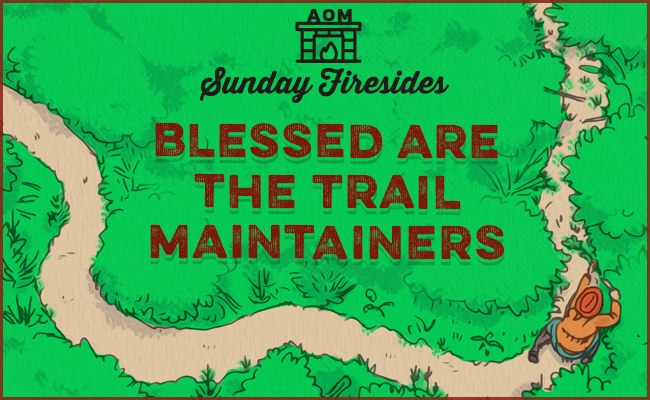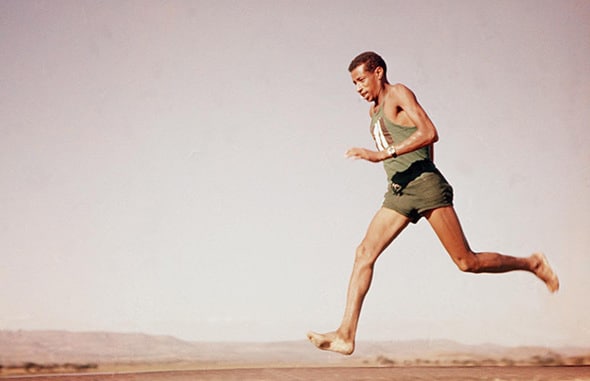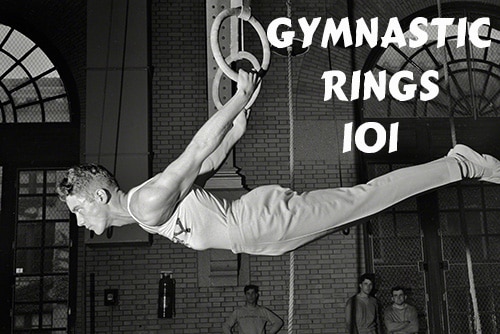
Editor’s Note: This is a guest post from Doug Hay.
Running is the most primal of sports. Just you, your legs, and the distance they can cover.
For many, it’s that simplicity that draws them in.
When we strip away the smooth roadways, bike paths, and wide sidewalks, we’re left with something even more fundamental, simple, grounding: trail running.
Trail running brings us back to the most basic of pleasures — moving quickly through the woods, over roots, rocks, and downed trees. It’s the adrenaline we once got from being chased, or from being on the other side and doing the hunting. And it’s the pleasure we found as children playing in the trees and splashing through mud puddles.
We run roads because they are convenient and offer an easy surface for a good workout. Trail running can be about ease and exercise as well, but it can also offer a path back to nature not found on a city street.
As John Muir once said, “The clearest way into the Universe is through a forest wilderness.”
And as more runners find the appeal in getting off the road and away from traffic, the sport has been growing in popularity. Trail races from 5ks to marathons are popping up in all sorts of communities. More and more people are pushing themselves in new ways by training for trail ultramarathons, and embracing the natural challenges we find in the wild.
There are countless reasons to try out trail running, and whether it’s for the thrill of the challenge, to fight against the growing nature deprivation disorder, or just for the joy of the workout that gets you motivated enough to try out trail running, it’ll be worth it.
Unfortunately, trails intimidate a lot of runners who are accustomed to the road. Here’s everything you’ll need to know before hitting the dirt.
Find Trails Near You
You don’t have to live in Boulder, Colorado or Park City, Utah to enjoy trail running.
I live in the heart of Washington, D.C., and with just a 5-minute jog for a warm-up, I can access nearly 15 miles of dirt singletrack (term used for a narrow hiking trail, only wide enough for one person) or horse trail, all without leaving the city limits. Trails are all around us, you just need to know where to look.
Start by checking hiking website like AllTrails.com. Popular hiking trails often lead you to some of the best running trails in your area.
Local county and state parks are also great resources for beginner trail runners. Even smaller parks often have a trail system perfect for a quick run through the woods. Don’t rule any park out before searching for its trails.
And of course larger national forests and parks are filled with good running trails. From desert paths to mountain scrambles, national parks are a trail runner’s playground. In popular parks you get the added bonus of that badass feeling that comes after blazing past hikers struggling up the same trail.
Most communities also have some sort of trail running club. Search and ask around, and you’re bound to find other trail-loving runners. Easily the best way to discover trails in your area is from others who already know them.
Trail Running Basics
Depending on the type of trail and terrain you are running, trail running can be very different than running on the road. These might sound like no-brainers to some, but here’s what I mean:
- Trails are rarely flat, and can quickly move from steep inclines to steep declines.
- Roads and sidewalks are generally smooth; trails feature rocks, roots, and any number of things to trip you up or slow you down.
- While soft dirt is better on your knees and legs than pavement, your feet and ankles tend to take a beating on rocky trails.
- Running through the wilderness introduces a new level of dangers that don’t exist in road running.
For many, it’s these challenges that keep them from even trying out the trail. And for first-time trail runners, the unsure footing can be frustrating as all get-out, but with a few adjustments to your running technique, you can tap that primal spirit and take on even the most technical of trails.
Slow down. The biggest mistake new trail runners make is trying to run at the same pace as they do on pavement. Time and pace on the road should never be compared to your time and pace on the trail.
Trail running means running with a different focus and a different form. When going out on the trail, adjust your speed to what feels comfortable and appropriate for that particular outing. Even if you aren’t moving as quickly, you’re still using the same amount of energy, if not more. Trying to keep a road pace can send your heart rate through the roof and cause major bonking. And nobody likes a major bonking.
Start by running a set amount of time instead of mileage. If you planned to run 5 miles, consider running for 45 or 50 minutes. That way you won’t be killing yourself just to get in the mileage.
Lift your feet. Don’t fault me for being obvious here, but trails can be very rocky and technical. That is probably the biggest adjustment for new trail runners.
We are often so used to running on smooth roads that we find it incredibly difficult to stay upright on bumpy singletrack. Teach yourself how to lift your feet and prepare for the different terrain.
I’ve learned this lesson the hard way, having fallen dozens of times on rocky trails. Bruises, cuts, wounds, and twisted ankles have all come from me not lifting my feet properly. That’s expected, and maybe even part of the fun. But by slowing down and lifting your feet, staying upright will be much less of a concern.
The good news is that the more time you spend on the trail, the less you’ll end up falling. As with anything else, we get better, and learning how to handle technical sections of trail comes with mileage.
Don’t be afraid to hike. I know, walking when you should be running? Lame.
Not so much with trail running. Because the trails are often much steeper, it can be more efficient to walk rather than run up a section of trail. Following certain cues like erratic breathing, major leg burning, or when the terrain dictates that it’s just as fast to hike as it is to run, you should be hiking.
When hiking instead of running, find a comfortable effort that lowers the heart rate but continues to push the pace, and avoid eating and drinking when climbing a hill in order to regulate your breath.
Hiking or walking on the trail isn’t a sign of weakness. Even the toughest of elite trail runners hike when it’s more efficient.
Let yourself get dirty. Trails are often muddy and wet. Instead of slowing down to tip-toe around a puddle or stream, embrace it. Charge through. Your shoes will dry, and with good socks, blisters shouldn’t be much of an issue.
Trying to stay clean by prancing around the mud will end up frustrating you more than anything else. Embrace all that the trail has to offer. It’s just part of the fun. After all, people pay good money to get muddy and run over obstacles. Trail running lets you do that for free.
Pay attention. With beautiful views, interesting trees, and frolicking animals all around you, it can be difficult to pay attention to the ground in front of you. But looking up at a tree or down at your GPS for longer than a quick glance may result in a mouth full of dirt, and dirt isn’t the most efficient way to get your fuel.
Survey the ground in front of you as you’re running in order to prepare for each stride. Split-second footing decisions could mean the difference between a rolled ankle or a clean run.
Same goes for when you’re running with others. Keep your distance from the runners in front and behind you so that each runner can properly prepare for the terrain. You don’t want to be the guy who takes down your friend because you were busy checking out a Hairy Woodpecker (you know, the bird, commonly found on the East Coast).
Safety Tips for Trail Runners
Trail running doesn’t automatically mean danger, but any time you’re in the woods, especially when you’re moving quickly, danger can arise. Take caution when going on a trail run. Your body, and your family, will appreciate it.
Here are a few tips to follow before hitting the trails:
- Plan the route ahead of time, and know the trails well or carry a map with you.
- Let someone know exactly where you’re going and when you plan to return.
- Be extra mindful of rocks and roots towards the end of the run when you’re getting tired.
- Carry a small amount of cash with you in case of emergencies.
- Avoid running after dark on your own, unless thoroughly planned ahead of time.
- If you drive to the trailhead, leave a small first-aid kit in the car to mend any scrapes or bruises after the run.
- Also if you drive to the trailhead, leave a note on your dashboard with your, name, route, and estimated time of finish.
- Bring a little extra water and fuel, just in case.
- Carry your phone for emergency calls.
- Have an emergency contact listed and an ID on your person.
Chances are nothing will happen, but it is much better to be safe than sorry.
Trail Running Gear
You don’t necessarily need new gear for trail running. Runners cross over between paved paths and dirt trails all the time without switching out a thing. But if you’re planning to spend a lot of time on the trail, here are a few pieces of gear worth investing in:
Trail running shoes. Look for a shoe that fits the type of terrain you’ll be on. If you’re running through rocky, technical terrain, a bulkier shoe with a rock plate and extra cushioning might be valuable. If the race is run on long stretches of road or gentle trail, a lighter, more versatile running shoe may do the trick.
Hydration. Because you might be on the trail longer, and have less access to public water sources, many trail runners will carry some sort of hydration system. The most popular is a handheld bottle for shorter runs, and a hydration pack or belt for longer outings.
Many systems will also include pockets for nutrition, such as an energy gel, energy bar, or food of your choosing. If you know you’ll be out for a while, it’s always a good idea to carry along some sort of fuel.
Light. This one is probably the least necessary for beginners, but if you plan to be on the trails around dawn or dusk, it’s a good idea to carry some sort of light. The most popular light source for trail runners is the headlamp, which can be picked up fairly cheaply at your local outdoors store. Some runners also prefer to carry a small flashlight.
If ultramarathons are in your future, many start before dawn, or run through the night. Carrying a light source is often a requirement for the nighttime hours.
6 Strength Exercises to Prepare You for Trail Running
Trail running requires more core strength and balance than road running. As you’re hopping off rocks, gliding down steep hills, or powering up a climb, you may wish you had focused on a few muscle groups ahead of time.
I regularly practice these strength exercises off the trail:
Balance and Leg Strength
- One-Legged Jump: Lift one bended leg off the ground, balancing on the slightly-bended other leg. Lift arms straight out in front of you. Hop forward and backwards on the balancing leg. Switch sides.
- Pistol Squats: Standing on one leg, lift arms straight in front of you. Now squat down, moving the lifted leg straight out. Repeat multiple times before switching sides.
- Single-Leg Balance: Stand straight up with one leg slightly lifted. Gradually move the lifted leg forward or to the side. Close your eyes for a more advanced version of this exercise.
Core Strength
- Bicycle: Lie on the floor with hands behind your head, and lift your legs, bringing your knees to your chest. Lift shoulder blades off the ground and extend the right leg while bringing the right shoulder towards your bended left knee. Rotate sides.
- Plank: Lie face down, placing your weight on your forearms and toes. Keep your body as stiff and straight as possible for as long as you can.
- Side Plank: Lie on your right side, stacking the legs on top of each other. Lift your body until the weight is on the right forearm (positioned directly under your shoulder) and side of right foot. Keep hips lifted and aligned straight with your upper legs and torso. Switch sides after you’ve held as long as you can.
Trail Running Doesn’t Have to Be Intimidating
It’s a lot of fun. And if you’re like me, it will totally change how you train, and how you think about running.
I remember so clearly the first time a friend took me out for a trail run. It was a new chapter, not just of my running, but of my life.
The first step is simply going out and giving it a try. Find a trail running club in your area or just a buddy who is willing to join. The thrill of the trail will keep you coming back. And who knows, it might just clear your path to the Universe.
See you on the trails.
Listen to our podcast on the myths and truths of distance running:
____________________________________
Doug Hay is an ultrarunner in constant search for the most remote corners he can find in the middle of a large metro area. He’s also the author of Discover Your Ultramarathon: A Beginner’s Guide to Running an Ultramarathon and the blogger behind RockCreekRunner.com.







